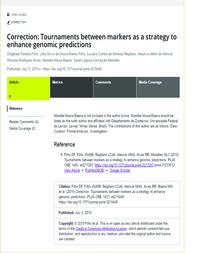Tournaments between markers as a strategy to enhance genomic predictions.
Tournaments between markers as a strategy to enhance genomic predictions.
Autoria: FERREIRA FILHO, D.; BUENO FILHO, J. S. de S.; REGITANO, L. C. de A.; ALENCAR, M. M. de; ALVES, R. R.; BAENA, M. M.; MEIRELLES, S. L. C.
Resumo: Analysis of a large number of markers is crucial in both genome-wide association studies (GWAS) and genome-wide selection (GWS). However there are two methodological issues that restrict statistical analysis: high dimensionality (p>>n) and multicollinearity. Although there are methodologies that can be used to fit models for data with high dimensionality (eg,the Bayesian Lasso), a big problem that can occurs in this cases is that the predictive ability of the model should perform well for the individuals used to fit the model, but should not perform well for other individuals, restricting the applicability of the model. This problem can be circumvent by applying some selection methodology to reduce the number of markers (but keeping the markers associated with the phenotypic trait) before adjusting a model to predict GBVs. We revisit a tournament-based strategy between marker samples, where each sample has good statistical properties for estimation: n>p and low collinearity. Such tournaments are elaborated using multiple linear regression to eliminate markers. This method is adapted from previous works found in the literature. We used simulated data as well as real data derived from a study with SNPs in beef cattle. Tournament strategies not only circumvent the p>>n issue, but also minimize spurious associations. For real data, when we selected a few more than 20 markers, we obtained correlations greater than 0.70 between predicted Genomic Breeding Values (GBVs) and phenotypes in validation groups of a cross-validation scheme; and when we selected a larger number of markers (more than 100), the correlations exceeded 0.90, showing the efficiency in identifying relevant SNPs (or segregations) for both GWAS and GWS. In the simulation study, we obtained similar results.
Ano de publicação: 2019
Tipo de publicação: Artigo de periódico
Unidade: Embrapa Pecuária Sudeste
Palavras-chave: GWAS, GWS, Genoma, Genome-wide, Genomic Breeding Values, Genótipo, Marcador Genético, SNPs, Seleção Genética
Observações
1 - Por padrão são exibidas publicações dos últimos 20 anos. Para encontrar publicações mais antigas, configure o filtro ano de publicação, colocando o ano a partir do qual você deseja encontrar publicações. O filtro está na coluna da esquerda na busca acima.
2 - Para ler algumas publicações da Embrapa (apenas as que estão em formato ePub), é necessário ter, no celular ou computador, um desses softwares gratuitos. Sistemas Android: Google Play Livros; IOS: iBooks; Windows e Linux: software Calibre.
Acesse outras publicações
Acesse a Base de Dados da Pesquisa Agropecuária (BDPA) para consultar o acervo completo das bibliotecas da Embrapa.

